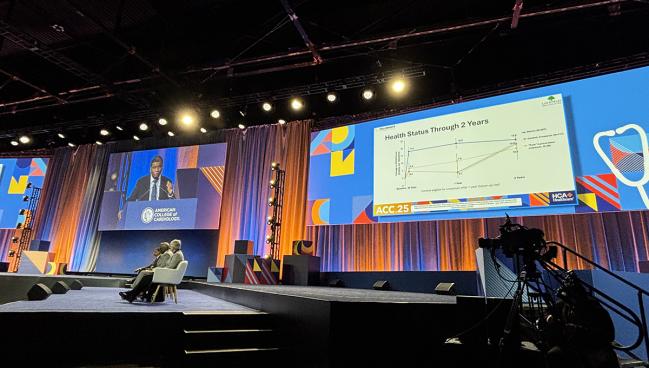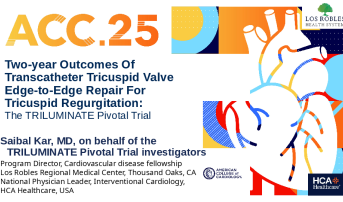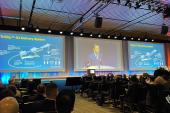By 2 Years, Tricuspid TEER Reduces Hospitalizations for HF: TRILUMINATE
The follow-up data bolster the gains in quality of life seen at 1 year and provide evidence of clinical benefit with TEER.

CHICAGO, IL—Two-year follow-up data from TRILUMINATE provide some evidence that transcatheter edge-to-edge repair (TEER) for severe tricuspid regurgitation (TR) does more than make patients feel better.
Treatment with TEER (TriClip; Abbott) significantly reduced hospitalizations for heart failure (HF) by 28% when compared with medical therapy alone, lead investigator Saibal Kar, MD (Los Robles Regional Medical Center, Thousand Oaks, CA), reported this week at the American College of Cardiology (ACC) 2025 Scientific Session.
“I think most people would agree, as clinicians, heart failure hospitalization is one of the worst things that can happen to a patient,” Kar told TCTMD. “It is bad for the patients, bad for the family, and bad for Medicaid, or society. If you have no mortality difference and you only have heart failure admissions, that's the biggest cost that you can have. So, heart failure hospitalizations are definitely a significant endpoint.”
The US Food and Drug Administration approved TEER last spring for patients with severe TR who are not candidates for surgery on the basis of TRILUMINATE. After 1 year, a primary composite outcome consisting of all-cause death or tricuspid valve surgery, HF hospitalization, and improvement in quality of life favored TEER over medical therapy alone
However, the benefit was driven by improved quality of life, a subjective endpoint in a study that lacked a sham-control arm. This led to some to wonder whether the improvement was attributable to a placebo effect and to question the role patient-reported outcomes should play in device approval.
Laura Davidson, MD (Northwestern University Feinberg School of Medicine, Chicago, IL), who spoke with the media during an ACC press conference, said the 1-year data showing a reduction in TR and improvement in quality of life is now bolstered by the decrease in HF hospitalizations.
“That is so important for patients,” she said. “It cannot be understated that a reduction in heart failure hospitalization is something that patients care a lot about. It’s a very important finding from this trial that we did not have from the 1-year data.”
It may also be important from a reimbursement perspective. The US Centers for Medicare & Medicaid Services recently agreed to reimburse transcatheter tricuspid valve replacement under its evidence development process, meaning that eligible procedures must be performed in the context of a CMS-approved study that includes all-cause mortality and/or HF hospitalizations with a minimum follow-up of 24 months.
Tricuspid TEER is not yet reimbursed by CMS but is currently under review, and a national coverage determination on reimbursement is expected by the end of the week.
‘Clear-cut’ Effect on HF Hospitalizations
TRILUMINATE used an adaptive design to assess safety and effectiveness, which allowed researchers to increase the sample size as the study progressed. The FDA approval was based on the results of the first 350 patients, but investigators observed a signal of increased 6-minute walk distances and fewer hospitalizations in 222 additional patients later enrolled.
The 2-year data, which were published in Circulation to coincide with ACC 2025, included all 572 patients (mean age 78.1 years; 58.9% female) randomized to TEER with TriClip or medical therapy. Roughly one-quarter of patients had a prior HF hospitalization in the year before study enrollment and half had torrential TR.
“Of importance with the 2-year data is that after 1 year, the patients were allowed to crossover based on their symptoms and the decision of the physician and patient,” said Kar. “As expected, 60% of patients crossed over between 1 and 2 years.”
In the intention-to-treat analysis, 84% of patients treated with TEER had moderate or less TR, an improvement that was sustained from 1 year. In the control arm, 63% of patients had moderate or less TR, which was primarily driven the patients who crossed over to TEER.
The annualized HF hospitalization rates were 0.19 and 0.26 per patient-year in the device and control arms, respectively (joint frailty HR 0.72; P = 0.02). Freedom from all-cause mortality, tricuspid valve surgery, and tricuspid valve intervention through 2 years was significantly higher with tricuspid TEER than in the control group, but this was driven by the control patients crossing over to TEER between 1 and 2 years. There was no difference in the risk of all-cause mortality or need for valve surgery.
“It’s clear-cut that there was a benefit,” said Kar. He pointed out that crossing from the control group to TEER was not counted as a hospitalization for HF, meaning that the benefit of TEER was likely attenuated. “If we didn’t have any crossover, the [HF hospitalization event] curves would have been separated even further,” Kar said.
Safety at 2 years was also maintained, with a stroke rate of 1.9% in the device group (vs 2.5% in the control arm). The rate of new conduction disturbances requiring a permanent pacemaker was 5.5% with TEER, and there were no reports of device embolization or thrombosis.
Crossover Group
Regarding the 142 patients who crossed over to TEER, 92% had the procedure within 6 months of their 1-year follow-up visit. Not surprisingly, those in the control arm who underwent TEER were more symptomatic, had a higher prevalence of torrential TR, had more hospitalizations for HF, and were more likely to have their diuretic doses upped between baseline and 1 year compared with those who didn’t cross over.
After switching to TEER, 81% of these patients had moderate or less TR at 2 years, whereas the percentage was 21% in controls who didn’t undergo TEER between 1 and 2 years. “This is actually quite reasonable because we are treating a heterogenous group of [patients with] functional TR, some of whom respond to medical therapy,” said Kar. “Obviously, when the patients are stable, they don’t cross over to TEER.”
Health status, as assessed by the Kansas City Cardiomyopathy Questionnaire, was stable in those originally randomized to TEER, improved in those who crossed over, and remained relatively stable from baseline in those who stayed in the control arm for all 2 years.
Gilbert Tang, MD (Mount Sinai Health System, New York, NY), has long argued that the improvement in health status with TEER at 1 year is not a placebo effect and at ACC he noted that they have shown data linking the improvement in TR grade to functional outcomes.
He also highlighted the crossover data, noting that they identified a particularly sick group of patients who benefit from therapy.
“If you hold patients for another year, they’re not necessarily dying, but they do need to be treated,” he told TCTMD. “Once they’re treated, their quality of life improved. I think that’s quite meaningful. There will always be a subgroup of patients—the sicker patients, the ones with the more TR—who will benefit with this therapy further.”
Michael O’Riordan is the Managing Editor for TCTMD. He completed his undergraduate degrees at Queen’s University in Kingston, ON, and…
Read Full BioSources
Kar S, Makkar RR, Whisenant BK, et al. Two-year outcomes of transcatheter edge-to-edge repair for severe tricuspid regurgitation: the TRILUMINATE pivotal randomized, controlled trial. Circulation. 2025;Epub ahead of print.
Disclosures
- Abbott funded TRILUMINATE.
- Kar reports consulting fees from Abbott, Boston Scientific, InterShunt, Medtronic, Peija, V-Wave, WL Gore; and Medtronic.






Comments